There are more than a thousand species of grass in the bamboo family, and many of the most popular bamboos for gardening come from the tropics or subtropics, so they much prefer the warmer climates. But with so many varieties to choose from, you can be sure that a sufficient number of bamboos will grow happily in the snowy mountain regions and far northern latitudes like Canada.
Dozens of varieties of cold-hardy bamboo can tolerate snowy winters and freezing temperatures. Many species will withstand temperatures as low as -10º to -20º F. In general, running bamboo is considered temperate, while clumping bamboo is mainly tropical. Runners, therefore, especially of the genus Phyllostachys, tend to be the most popular in cold climates. But some of the cold-hardiest bamboo species are clumpers, from the genus Fargesia.
Note: This article first appeared in January 2019, last updated in February 2024.

Which bamboo can I grow in the snow?
We hear this question all the time, especially from our friends in Canada. Can I grow bamboo in the snow?
The short answer is YES. But the long answer is that it really depends on what variety of bamboo you are growing. Running bamboo tends to be more suitable for cold climates. But there are also a few varieties of clumping bamboo that can withstand a deep freeze,
Phyllostachys is one of the most widespread genera of bamboo, primarily native to China and including about 50 distinct species. Almost every species of Phyllostachys is a fast-spreading runner (with an aggressive rhizome root system), and many of them are cold-hardy, down to -5 or -10º F. But you’ll want to keep a close eye on these running bamboos to be sure they don’t become invasive, as runners sometimes do.
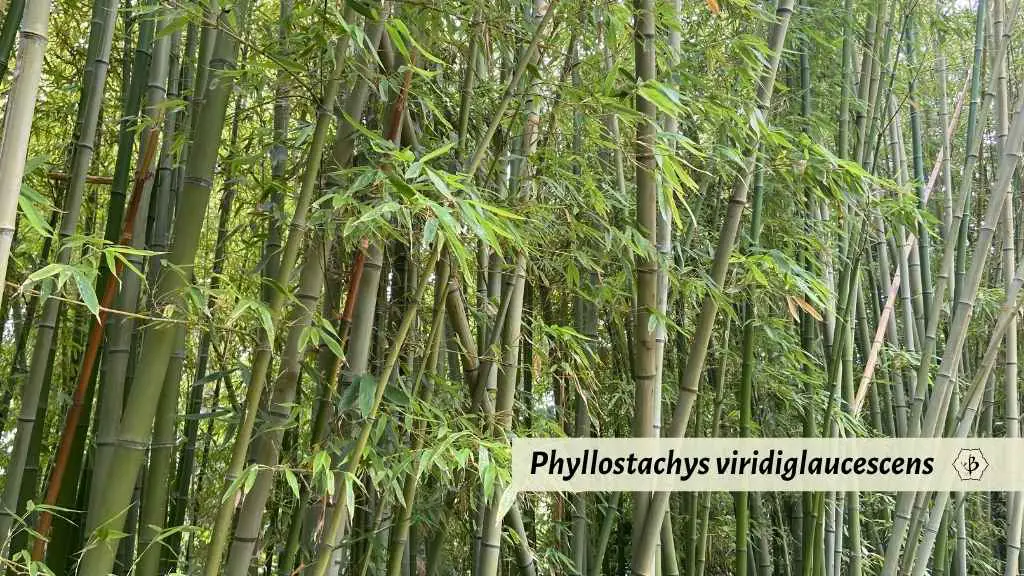
Fargesia is another major genus of bamboo, also indigenous to China and Southeast Asia. Unlike Phyllostachys, the Fargesia bamboos are chiefly dense-growing clumpers. This and their extreme cold hardiness have made many varieties of Fargesia very popular among gardeners. The fact is, most clumping bamboos come from tropical and subtropical climates, so cold-hardy clumpers are especially rare and desirable.
| Botanical name | Common name | Description |
| Phyllostachys aureosulcata | Yellow groove bamboo | Running bamboo with distinctive yellow stripe |
| Phyllostachys heteroclada f. solida | Water bamboo | Running bamboo with solid (rather than hollow) canes |
| Phyllostachys bissetii | Bissetii | Running bamboo with dense dark green foliage |
| Phyllostachys nuda | Nuda | Running bamboo with an attractive appearance |
| Phyllostachys atrovaginata | Incense bamboo | Running bamboo with waxy, aromatic coating |
| Phyllostachys parvifolia | Running bamboo with thick canes and small leaves | |
| Phyllostachys vivax | Vivax | Running timber bamboo |
| Fargesia murielae | Umbrella bamboo | Clumping bamboo with colorful bluish culms |
| Fargesia nitida | Blue fountain bamboo | Clumping with colorful culms and cascading leaves |
| Fargesia dracocephala | Dragon head bamboo | Clumping with thick canes and weeping foliage |
| Fargesia rufa | Rufa | Clumping bamboo for cool, shady areas |
| Fargesia sp. ‘Jiuzhaigou’ | Red dragon, Black cherry | Clumping bamboo, compact but colorful |
| Indocalamus tessellatus | Giant leaf bamboo | Short, shrubby runner with giant leaves |
| Bashania fargesii | Windbreak bamboo | Very aggressive runner, with sturdy upright culms |
| Sasa palmata | Dwarf variety with vigorous, running rhizomes |

Cold hardy runners
- Phyllostachys aureosulcata: The “yellow groove bamboo” is easily recognizable for the yellow stripe that’s visible on the dark green culms. A subspecies known as “crookstem bamboo” has shoots that sometimes grow in a zig-zag manner. This visually interesting and attractive variety can grow up to nearly 50 feet in height, even in freezing temperatures. But in zones where it regularly gets below -10 or 15º F, it probably won’t grow more than 10 feet tall.
- Phyllostachys heteroclada f. solida: This subspecies of “water bamboo” is commonly known as “solid bamboo”. It’s one of the few varieties that actually has a solid stem, rather than being hollow inside. It’s also a bit more cold-resistant than ordinary water bamboo, hardy down to -10º F.
- Phyllostachys bissetii: Very dense-growing, with a thick bushy canopy, and very cold hardy. The one-inch shoots will grow up to about 20 feet in height. Cold hardy to at least -10º F, even down to -25º with proper mulching.
- Phyllostachys nuda: A very attractive and cold-hardy species, its shoots get 1-2 inches in diameter and 25-30 feet in height. Young shoots appear very dark, almost black, turning a rich, dark green as they mature, usually with pretty, white rings around the culm nodes.
- Phyllostachys atrovaginata: Popularly known as “incense bamboo”, this variety has a waxy coat that gives the culms a very pleasant fragrance in hot weather or when rubbed. Many gardeners appreciate how fast this bamboo grows, with thick culms of 3 inches or more in diameter and up to about 40 feet in height. Good at temperatures as low as -10 or 15º F.
- Phyllostachys parvifolia: Like water bamboo, the rhizomes of this species are well adapted for wet and saturated soil. Small leaves make the thick, dark green culms stand out, and the white rings around the nodes give them even more character. Fresh shoots of this variety are reputed to be delicious in flavor. Mature shoots can get up to 40 feet tall, and it is cold hardy down to -15º F.
- Bashania fargesii: The thick, sturdy culms with dense foliage make this an especially popular choice for windbreaks and privacy screens. It’s also one of the most vigorous growers, so watch out! Native to the mountains of southern China, this species is cold hardy down to around 0º F. Culms reach about 2 inches in diameter and 20 to 30 feet in height, with unusually long internodes.
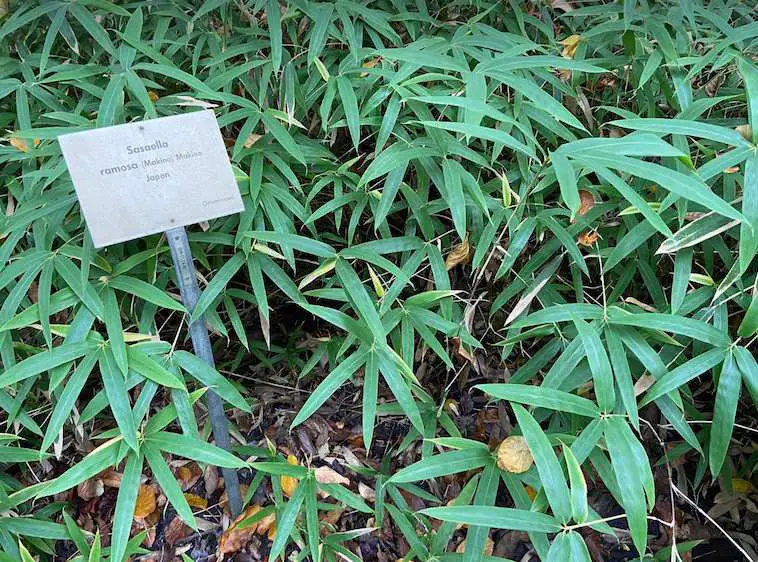
You might also look for some Arundinaria, the only genus of bamboo indigenous to the United States. Despite being native, it’s not easy to find in nurseries. Arundinaria gigantea ‘Macon’ is an exceptionally hardy cultivar that also does well in wet soil.
Sasa and Sasaella, two bamboo genera from Japan and eastern China are also known to be very cold-hardy. And one species of Sasa is native to Russia! For the most part, these are small, dwarf varieties of bamboo that make excellent hedges or ground covers, keeping green all year around.
REMEMBER: If you’re planting running bamboo, like any Phyllostachys variety, always use a root barrier. Check out this Deep Root Barrier available from Amazon. Also, check out our list of bamboo gardening supplies and this detailed article on bamboo containment practices.

Cold hardy clumpers
- Fargesia murielae: Commonly known as “umbrella bamboo”, many consider this to be among the most beautiful varieties for cultivation. New shoots have a light blue hue, turning dark green and yellow with age. Growing this bamboo in a shady area will help preserve the rich blue shade. Thin shoots will get about 12 feet tall, and it’s hardy down to -20º F.
- Fargesia nitida: “Blue fountain bamboo” earned its name from the dark purple, bluish culms and the thick, cascading canopy of foliage. One-inch poles can get to about 15 feet tall, and thrive in temperatures as low as -20º F.
- Fargesia dracocephala: “Dragon head bamboo” has thick culms growing to about 10 feet, with a thick, weeping leaf canopy that can provide a good privacy hedge. Not recommended for hot, humid climates, but cold hardy down to -10º F.
- Fargesia rufa: A compact, thick and bushy variety, Rufa much prefers cooler climates, and also does well in partial shade, protected from afternoon sun. This species is hardy down to -15º F. Thin culms grow to about 10 feet tall.
- Fargesia sp. ‘Jiuzhaigou’: This species includes many interesting and cold-hardy cultivars, including “red dragon” and “black cherry”. As the names suggest, these are some more colorful varietals. With thin culms growing to around 10 feet, this is a more compact species of bamboo, but cold hardy down to -20º F. Pack your bags for Canada!
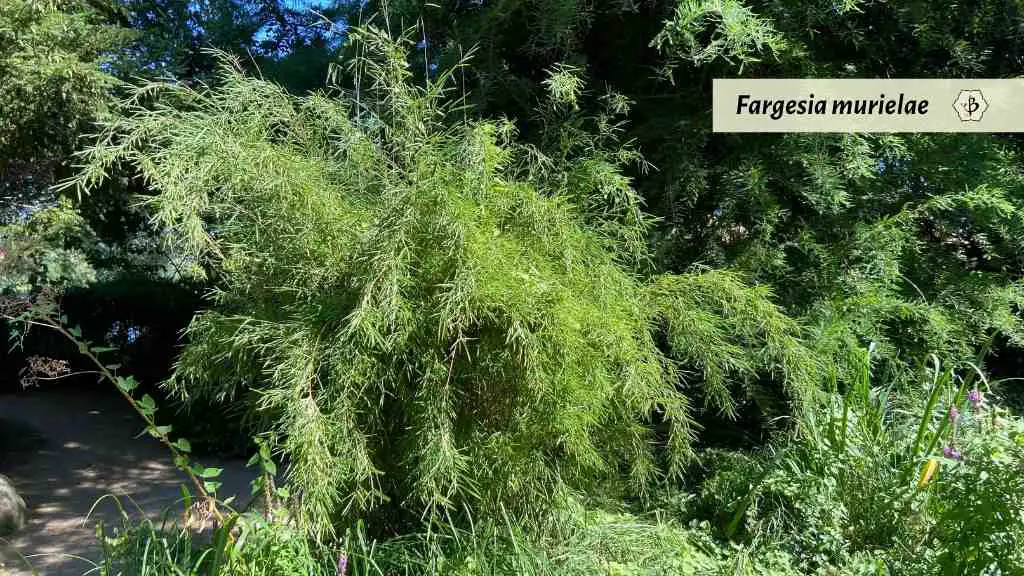
For more cold-tolerant clumping bamboo, you might also look into Borinda, Chusquea, and Himalayacalamus.
Growing Bamboo in the Cold
As you can see, there is plenty of bamboo to choose from if you’re looking to landscape an oriental-style garden in the northern habitats of the US, Canada or even Europe. Most of these species are hardy into the negative Fahrenheit territory, so as long as you aren’t expecting to dip below minus 20º or something, you should be fine. And even if the leaves get a little fried in an abnormally severe cold snap, the roots should still endure.
To give your bamboo some even greater protection against the cold, you may want to provide them with some extra heavy mulch. Normally, bamboo mulches itself as it loses leaves, but in a harsh winter climate, you’ll need to add at least a few inches of bark, wood chips or even pine needles. This will help the roots to retain moisture and keep warm, ensuring a healthy surge of new shoots when spring comes around.
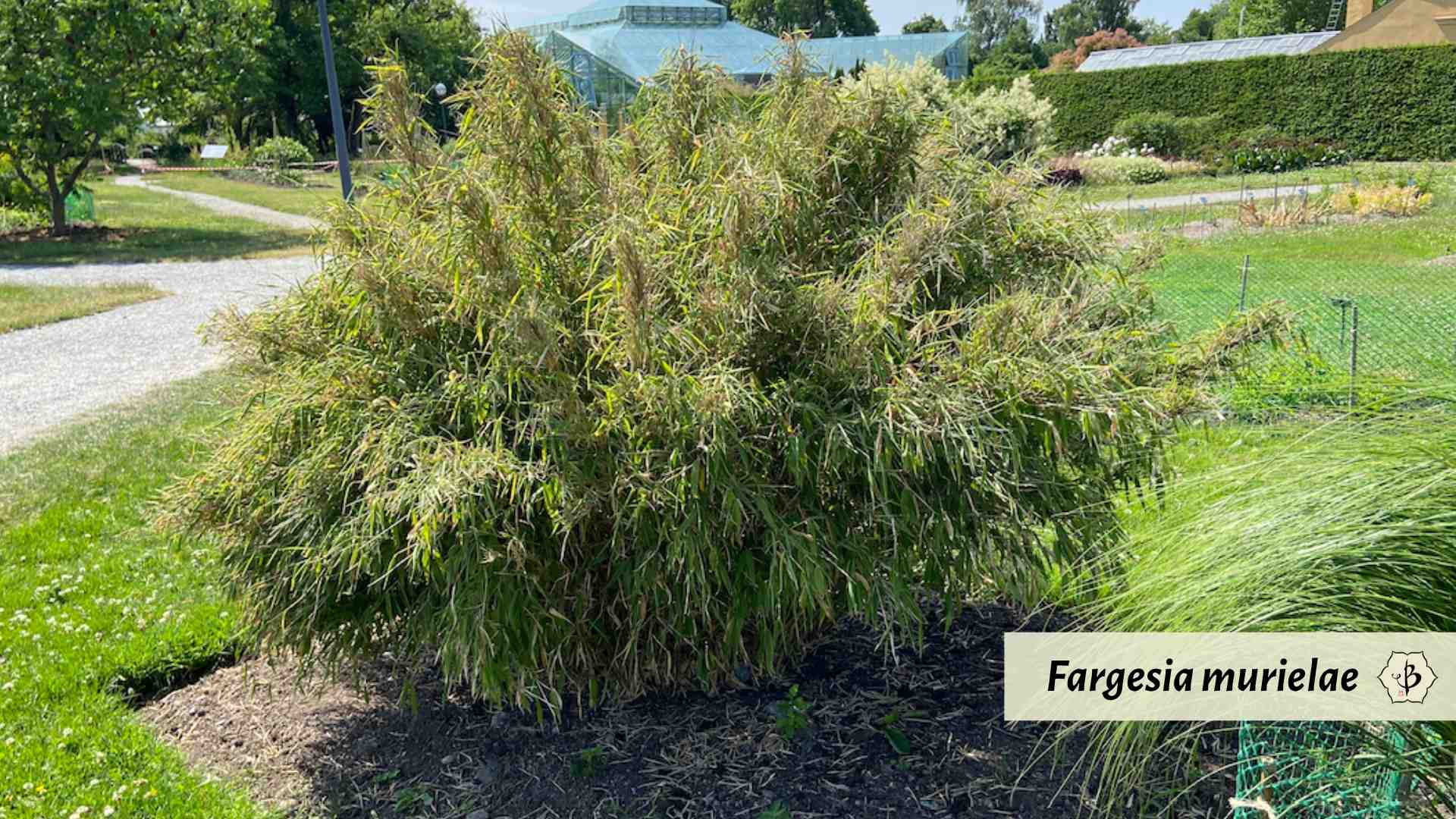
Have fun gardening, and if you have any photos of snowmen in your bamboo grove, please send them our way!
Learn more
If you found this article about cold hardy bamboo helpful, please consider sharing it with your friends and subscribing to our blog. Chances are, you’ll also enjoy some of these popular posts:
- Growing Bamboo: A how-to guide
- Where to find bamboo in Canada
- Growing bamboo in the shade
- Water bamboo: Growing around ponds and wetlands
- Should I plant a bamboo hedge?
- Running bamboo: Why must you run?
- Best clumping bamboos: Never run again
- Best bamboos for building and construction
- Cold hardy bamboo – Web Story
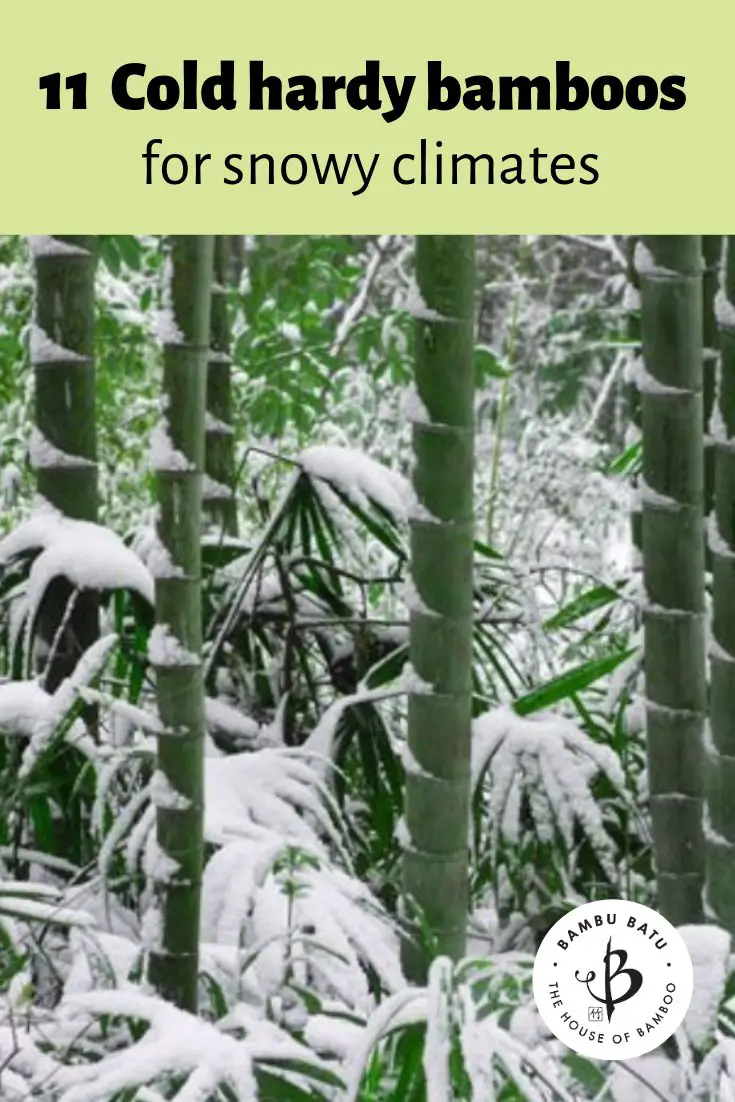





















Which cold harty variety would make the best poles 1/2” -1 1/2”. I live in zone 6-central(N-S) western Kansas.
I would recommend Phyllostachys atrovaginata (“incense bamboo”) or Phyllostachys nuda. Try a couple varieties and see which one grows better in your specific soil and climate.
I m looking for some to grow in zone 5 that grows with nodes about 15 or more inches apart that the walls aren’t too thin for crafting purposes (kite spars,flypoles and knitting needles)what’s prescribed in this situation?
Try Phyllostachys rubromarginata (red margin bamboo). It’s a relatively popular variety and frequently used for crafts. Also Bashania Fargesii for exceptionally long internodes.
Craig, Did you get to try any of the suggested varieties of Bamboo, we are also in Western Kansas and would love to know what you found.
I’d suggest Henon if you want a big timber bamboo, or else red margin bamboo or bissetii if you want something smaller. Phyllostachys heteroclada is another good choice.
Thank you Fred. I tried bisseti, did not survive our winters, but probably because we had it planted in an oval stock tank, and the roots probably froze. Where is/are some good locations online to purchase bamboo? FYI USDA Zone 5a can get down as low as -18ºF to -20ºF
Hi Owen, Sorry to hear about that. You might try Phyllostachys atrovaginata, or else resort to Fargesia, the hardiest bamboo genus of all. You can find a list of bamboo nurseries by region on our “Links & Resources” page, which is linked at the bottom of the bottom page, in the footer of our website.
I live in Eastern Washington State, and our temperatures range from 0°f in the winter to 100°f in the summer. Is there a bamboo that would thrive in this area?
Sounds like you’re in USDA zone 5. So most of the bamboos in this article should do fine in your garden, as they are all cold hardy to sub-zero temperatures. As long as they get sufficient water in the summer, the high temperatures should not be a problem either. You might have to water it every day if it’s over 100, especially a young specimen that’s not very well established yet. Try calling some local nurseries and see what they have.
I live in the middle of the lower peninsula of Michigan. I’m considering growing bamboo to fill an area clear cut by the power company. The area in question is swampy and is rarely dry. Often there is standing water, mostly in the Spring. Temperatures can hit 100 degrees for a few days in the summer and 15 below zero for a few days in the winter. I would like something attractive that might not exceed 10-12 feet. What spieces of bamboo might you recommend I consider? Thanks for your help.
Hi John, Those are some interesting growing conditions! Phyllostachys heteroclada is pretty cold hardy and can grow in wet / saturated soil. In ideal conditions it can grow over 30′, but I think the conditions you describe are less than ideal, so it probably won’t get that big. Phyllostachys parvifolia might be an even better choice. It’s supposed to be cold hardy down to -15 and grows up to 20 or 30′ tall. But if there is so much standing water, bamboo might not be your best choice, especially if it stay wet for more than about 5 days at a time.
hi, I live in EL calafate, patagonia Argentina. What spieces of bamboo might you recommend to grow down here??????BRDS
Hi Patricia, I’m curious if you found a good bamboo species in El Calafate. I’m looking to grow bamboo near Punta Arenas, a bit further south in Chile.
The plan is to grow bamboo commercially for biomass. Any advice will be useful.
I Live in Arkansas and we have semi Rock clay mixture sprinkles of dirt, some areas sop up water and some have actual dirt but mostly we’ve become semi subtropical this winter hasn’t been winter it’s been basically above 30 f all winter which is definitely new down here. We we’ve gone from area 6 to 6a to 7 so yha and we’re getting way mor rain then usual my great uncle farms a few hours away and he’s been flooded out in some spots which has happened in about 45 closer to 50 years
Hi I live in Minneapolis Minnesota and am zone 4…looking for a fast growing hedge? I have Very sandy soil with high pH because of oak trees…any suggestions? Thank you ????
I would recommend some variety of Phyllostachys. Most Phyllostachys species tend to do well in the cold, and they are fast growing runners. To contain it better (prevent it from spreading too much), and to avoid the problems of the high pH soil, I would suggest planting the bamboo hedge in a raised bed or some sort of large containers.
Hi, really nice article! Thank you for all the detailed information. What is the type of bamboo that can survive in the climate in Bulgaria (Europe). I live in area that is between continental and sub tropical climate, but more like continental I guess. We have rainy sunny spring, hot dry summers (sometimes hits +40 C), autumn with mild temperatures and sunny dry winters, but sometimes with 30-40 cm snowfall and temperatures dropping down to -15…-20 C for a week or two. I would say that such cold occurs once in every 3-5 years, mostly it’s -2..-3 during night and +2..+5 during day in Dec. to Feb. Please can you give me advice for a bamboo that can survive and grow on it’s own, without additional watering? My town Yambol is 100 km inland from the Black sea and it’s considered 7 Hardiness Zone. Thank you
I don’t have much experience gardening in Bulgaria, but I would try selecting a few bamboos from the list above, and see which ones do the best. It may take a couple years before you know for sure. In any case, they will need to be watered in the summer. You can also try planting in shady or partly shady areas since the summers are so hot.
Good day Ori.
If you’re still wondering, then there are two species which would work well. These are runners, so they need a barrier. I do not know the rules in Bulgaria, but running bamboo may be illegal to plant in some places.
The best species for cold zones is Phyllostachys vivax, as it grows largest in colder zones. In northern France they grow to 8-9 cm diameter and more than 12 m tall.
Phyllostachys iridescens also grows well in colder zones, but not quite as large as P. vivax.
It is stronger and more upright than vivax.
I think those two will grow well where you live.
Hi, I live in Homer, AK which is technically zone 5, but acts more like zone 3-4. We have cool rainy short summers and long cold winters, but does not get below -20F. I am interested in bunching or running varieties. Our soils are silty, so moderately well drained, but very high organic matter (because things dont break down quickly here). Do you think any of these will work well for me? I plan to try a few out.
Hi Brad, Those sound like difficult conditions, but try a few of these, like you said, and see which ones do the best. Phyllostachys violascens is another variety I’ve heard about that’s very cold hardy. It also has some interesting yellow/green stripes.
Good day! Your site has great info. Looking to grow a fence line around a few acres of property… clumper? Runner? Ideal species for Shuswap Lake, British Columbia, BC, Canada?
Many thanks in advance.
R
Sub irrigated soil. Approx. 10% grade. Damp silt. Moderate sun
If you have a few acres, I would suggest a running bamboo. Maybe put a root barrier along the property line if you’re worried about the neighboring property. The runners do much better up there in the cold, so any variety of phyllostachys. Vivax is an impressive timber, I’d be curious to see how tall it gets in BC.
Hi, just curious if any species would be suitable for south east Alberta, Canada. Thanks!
Yes, I think you can try some of these species and see how they do. We’ve made the same recommendations for growing in Canada.
I’d like to grow Dragon Bamboo in large pots; we live in Whistler.
Should I bring the pots in over winter?
Thank you
That’s probably a good idea, just for 2 or 3 months.
What is best bamboo for hedge screen that will grow about 20’ tall and be able to withstand temp extremes from + 40 Celsius to -15 Celsius. We live in Okanagan region of BC Canada. Want something easy to maintain as access for maintenance is limited as it will be behind a fence.
Thank you.
Probably Phyllostachys bissetii is your best choice. Just be careful. It spreads quickly.
Which bamboo species do you recommend for privacy above a 6′ fence, that will live in a 24″ diameter planter, full sun/exposure, outside year-round?
This plant will be located in Golden, CO
I’d suggest Fargesia dracocephala aka Dragon head bamboo. It’s a beautiful variety and about the right height for your needs. A clumping bamboo will be easier to keep in a pot also. (Even so, you’ll probably have to take it out and trim the roots or divide the root ball every 2 or 3 years, best in late autumn.)
Which runner would be best if I live in sugar house, slc, utah…and I want a fast growing bamboo that is the most wide possible in diameter? I don’t care about looks but hight might be nice but not necessary. 🙂
Hi Sarah, I’m not sure how big it will get in Utah, but you can try Phyllostachys vivax, it’s a cold hardy timber variety.
Thank you!! Where could I find starts to grow? Or would I try seeds? I would prefer starts…
Where could I get Phyllostachys vivax starts? Is there an online website that I could order them from?
Check out this directory of bamboo nurseries, many of them do mail order.
Can you recommend where to purchase seeds? I want a variety of fargesia clumping cold weather. Thank You Randy
Seeds are difficult to obtain, especially viable and accurately identified seeds. Better to buy live plants. Check our nursery directory.
Hi there!
I am interested in growing some bamboo in Michigan (Zone 5a) which can be used for some building of structures. I am thinking p. Vivax may be a good option as you refer to it as “timber” like. Would I be able to split it and use it for things that are bigger than crafts? Like a playhouse for the kids?
Hi Patricia, Check out this article about Temperate Timber Bamboos for cold climates. Henon and Madake might be better options for your purposes. Good luck!
Can I grow Hawaii Clumping Bamboo in Memphis, TN area?
I don’t think it would do well in the winter frost. You might try planting Bambusa oldhamii. It’s a little more frost tolerant.
https://bambubatu.com/bambusa-oldhamii-chinese-timber-bamboo/
Hi, I have a small Fargesia sp. ‘Jiuzhaigou’ IV Black Cherry growing against the north-facing foundation of our home in zone 7A. It’s in ground, surrounded by a paving stone walkway. The spot is approx. 1.5 square yards, which I amended with a lot of well-composted horse manure. It gets just a bit of dappled morning sun, after which the house keeps the spot from getting any afternoon sun.
The plant’s doing really well since I put it in ground a month ago, with a bunch of new growth.
I would like to cover the bases so it comes through its first winter (when it comes) with flying colors.
I’m figuring on mulching it with about 6 inches of pine needles.
Should that take care if it?
Thanks!
Sounds like a perfect plan, Noel!